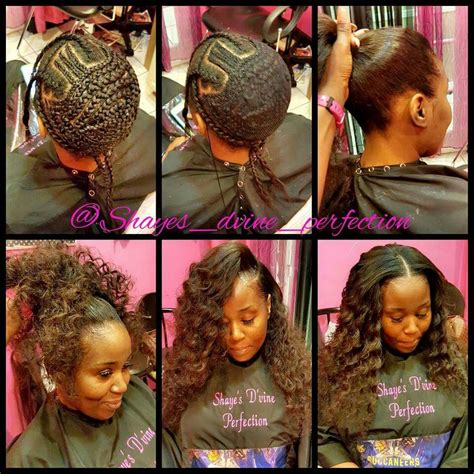Introduction
Sew-in braids, also known as invisible braids, are a versatile and stylish protective hairstyle that has gained immense popularity in recent years. They involve braiding the natural hair tightly against the scalp and sewing in extensions for added length, volume, and color. With countless pattern options available, there’s a sew-in braid pattern to suit every face shape, hair texture, and personal style.

Understanding Pain Points and Motivations
Pain Points:
- Time-consuming: Sew-in braids require significant time to install, typically taking 4-8 hours depending on the desired pattern and the length of the extensions.
- Maintenance: Regular maintenance is necessary to keep sew-in braids looking their best, including shampooing, conditioning, and managing frizz.
- Tension: Tight braiding can cause tension on the scalp, leading to discomfort or even hair loss in some cases.
Motivations:
- Protective styling: Sew-in braids offer exceptional hair protection from heat styling, chemical treatments, and breakage.
- Length and volume: They can instantly add significant length and volume to natural hair, creating a glamorous and dramatic look.
- Versatility: Sew-in braids can be styled in a multitude of ways, from sleek buns and ponytails to intricate braids and updos.
Choosing the Right Pattern
The key to a stunning sew-in braid hairstyle lies in selecting the pattern that best complements your face shape and hair texture.
- Oval faces: Almost any pattern suits oval faces, including side braids, cornrows, and goddess braids.
- Round faces: Patterns that create height and length, such as box braids and Senegalese twists, can help elongate the face.
- Square faces: Asymmetrical patterns, such as side-swept braids and waterfall braids, can soften angular features.
- Heart-shaped faces: Patterns that narrow at the forehead, such as French braids and fishtail braids, can create a more balanced look.
4 Essential Tables
Table 1: Sew-In Braid Pattern Categories
| Category | Description |
|---|---|
| Cornrows | Tightly braided rows of hair running parallel to each other |
| Box Braids | Square-shaped sections of hair braided together in rows |
| Goddess Braids | Intricate patterns of braids that create an elegant and regal look |
| Senegalese Twists | Two-strand twists that create a curly or wavy texture |
Table 2: Pattern Variations
| Variation | Description |
|---|---|
| Side braids | Braids swept to one side of the head |
| French braids | Three-strand braids where the side sections are crossed over the middle section |
| Dutch braids | Similar to French braids, but the side sections are crossed under the middle section |
| Fishtail braids | A pattern that resembles a fishtail |
Table 3: Pattern Density
| Density | Description |
|---|---|
| Low density | Fewer braids or twists, resulting in a looser and more natural look |
| Medium density | A moderate number of braids or twists, providing a balance of coverage and volume |
| High density | Numerous braids or twists, creating a tighter and more intricate look |
Table 4: Pattern Length
| Length | Description |
|---|---|
| Short | Braids or twists that extend just below the shoulders |
| Medium | Braids or twists that reach mid-back |
| Long | Braids or twists that fall below the waist |
Step-by-Step Installation Process
Materials:
- Kanekalon or human hair extensions
- Needle and thread
- Braiding hair
- Styling products
Steps:
- Prepare the hair: Wash and blow-dry the natural hair to remove any oils or product buildup.
- Section the hair: Divide the hair into small, even sections.
- Braid the natural hair: Create tight, cornrow-style braids against the scalp.
- Attach the extensions: Thread the needle and sew the extensions onto the cornrows, starting at the root and working your way down.
- Secure the ends: Knot the ends of the thread securely and trim any excess extension hair.
- Style and finish: Apply styling products and style the sew-in braids as desired.
Tips and Tricks
- Use a curved needle to make it easier to sew in the extensions.
- Avoid shampooing your sew-in braids too frequently, as it can loosen the extensions.
- Deep condition your sew-in braids regularly to keep them hydrated and healthy.
- Use a satin pillowcase to prevent friction and tangling.
- Get regular touch-ups to tighten the braids and maintain the desired look.
Common Mistakes to Avoid
- Over-tightening the braids: This can cause tension and discomfort on the scalp.
- Using low-quality extensions: Cheap extensions can tangle easily and last for a shorter period of time.
- Not prepping the hair properly: Failure to remove oils and product buildup can compromise the adhesion of the extensions.
- Shampooing too frequently: Excessive shampooing can dry out the extensions and lead to frizz.
- Ignoring maintenance: Neglecting touch-ups and deep conditioning can shorten the lifespan of sew-in braids.
Inspiring Applications
Beyond traditional hairstyles, sew-in braids can also be used to create innovative and stylish applications:
- Hair art: Create intricate patterns and designs on the scalp using different braid patterns and colors.
- Wig-making: Sew-in braids can serve as a base for custom-made wigs, allowing for endless customization options.
- Braided accessories: Braided headbands, hair clips, and jewelry can add a touch of flair to any outfit.
- Therapeutic braiding: The repetitive motion of braiding can have a calming and meditative effect.
Conclusion
Sew-in braids reign supreme as a versatile, protective, and stylish hair extension technique. With countless pattern options available, there’s a perfect sew-in braid hairstyle for every face shape, hair texture, and personal style. By following the tips and tricks provided, avoiding common mistakes, and exploring inspiring applications, you can achieve stunning and long-lasting sew-in braid styles that turn heads and boost your confidence.
